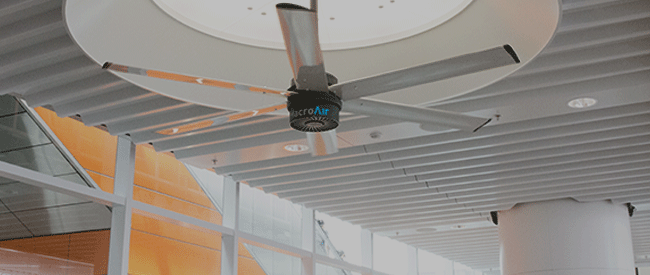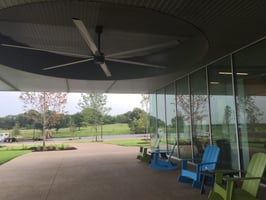Created as the “Grand Central Station of the West,” the Salesforce Transit Center is a $2.3 billion...
MacroAir Made it to Salesforce Transit Center
In this episode of MacroAir’s Vlog you will experience the journey that our marketing team took into San Francisco to film MacroAir fans at work and to tell a compelling story. The Vlog has some interesting stops at unique locations that only a city like San Francisco could provide. The journey ultimately leads the team to the 27 MacroAir big commercial fans used to cool the brand new Salesforce Transit Center’s bus terminal.
A Robot Made Our Coffee
It’s was only fitting that when our team stopped at a local coffee shop for an expresso, a robot arm made the coffee and served it to them. San Francisco is the technological innovation hub of America. Thousands who work in the IT industry call the city of San Francisco home, and the famed Silicon Valley is located in the southern San Francisco Bay Area.
Hundreds of tech companies, from industry leaders like Apple, Facebook, Google, and Salesforce to an ever-changing array of startups, are based in this innovative community. Not only are MacroAir big commercial fans the perfect fit for the new Salesforce Transit Center, our culture is also a great fit for the city’s forward thinking.
“What’s really special about this project is how a significant company like Salesforce created a landmark Transit Center—the “Grand Central Station of the West”—in such an influential city like San Francisco.” Mike Teruel, Digital Media Specialist, MacroAir
Big Commercial Fans for a Big Design Project
Let’s not get to far into the future, the overall goal of the trip for our marketing team was to film and tell the story of MacroAir fans in the “Grand Central Station of the West,” the Salesforce Transit Center. This $2.3 billion project that has been more than 10 years in the making is the latest in urban planning: a massive contemporary, sustainable space in the heart of San Francisco.
“Salesforce Transit Center is a state-of-the-art multimodal transit station in downtown San Francisco.”- Project Architect, Pelli Clarke Pelli Architects
The Salesforce Transit Center will serve 11 transportation systems throughout the Bay Area. The structure is 1.5 million square feet total; four levels above ground, two below. Once completed the belowground concourse level will be a train platform for California High Speed Rail transporting passengers from Los Angeles to San Francisco and back.
The structure has many features that support its long-term goals of sustainability. For example, its lighting will be completely shut off during off-peak hours due to massive skylights designed into the structure. Also, MacroAir fans activate automatically when CO2 levels or temperatures are too high on the bus deck creating a comfortable space with good indoor air quality, all while saving energy for the transit center.
Part of a Bigger Sustainability Conversation
As climate change becomes an increasingly pressing concern, so too does the need to create sustainable buildings like Salesforce Transit Center that offer minimal environmental impact and maximum human comfort.
Sustainable considerations such as energy efficiency are now regulated by building codes in most major cities in America, this makes it a top priority for architects to conserve resources and materials and construct dwellings that work with their natural surroundings rather than against them.
So what makes a sustainable building? Simply put, it’s one that has minimal environmental impact while simultaneously meeting its occupants’ various needs. Environmentally sustainable buildings attempt to minimize a building’s environmental impact through energy efficient methods like the use of big commercial ceiling fans, use of sustainable materials and landscaping that considers an environment’s biodiversity and existing natural features.
Design elements such as MacroAir big commercial fans are integrated with the transit center’s Building Management Systems (BMS). The center’s CO2 sensors are tied into the BMS and can detect temperature and CO2 levels emitted from the buses that arrive at the center. Because the systems are integrated with the BMS, the BMS can activate the fans when CO2 levels or temperatures are too high.
The Salesforce Transit Center has much more control over the way MacroAir fans and the structure work together. This provides tremendous reductions in the amount of energy used to heat, cool or ventilate the transit center. The integrated fans are a key component that will increase comfort and air quality for the tens of thousands of commuters that are expected to pass through the transit center every day.
Time Traveling
The journey that our marketing team took to the Salesforce Transit Center tells the story of how big commercial fans are a key component to the future of city structural designs. This Vlog episode paints a picture of a bright future where the people of San Francisco will utilize a sustainable structure. It tells the story of a major city structure with massive skylights, trees, plants, integrated art and technology like MacroAir large ceiling fans that help create comfort and sustainability from above. The Vlog even suggests that all future cafes will have robot arms that serve you coffee.
Click the link below to learn more about how MacroAir Fans can play a key role in sustainable design


